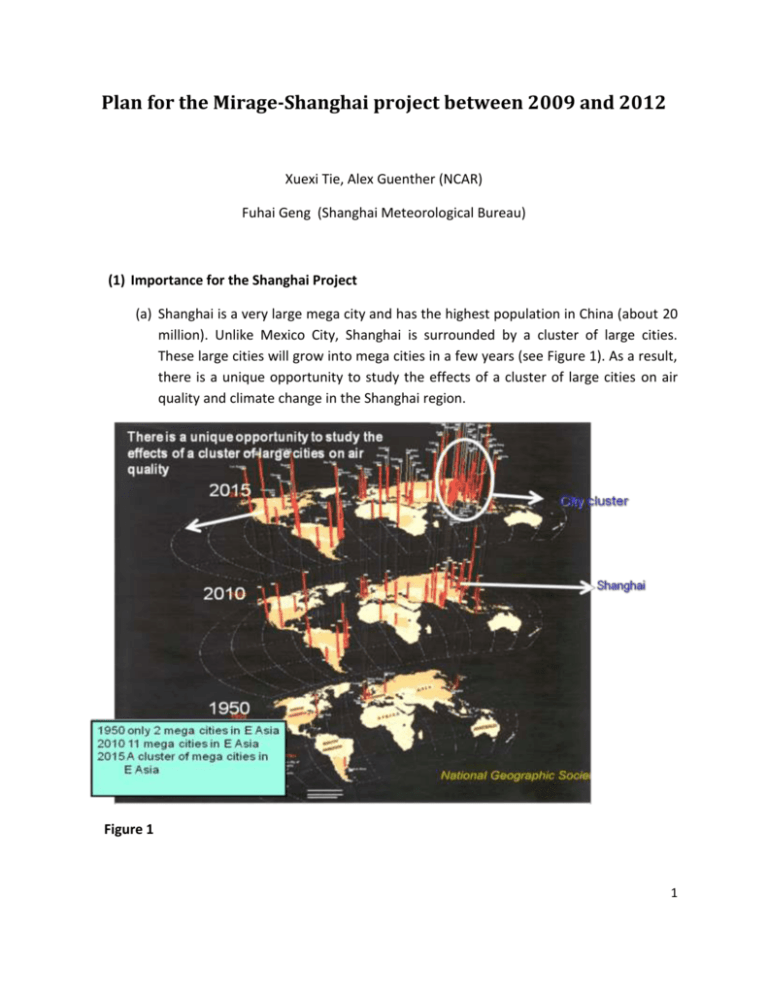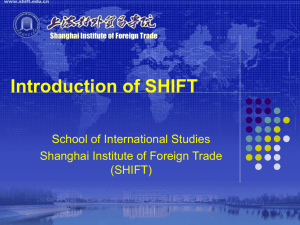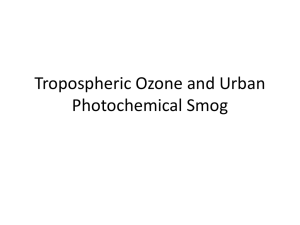white paper
advertisement

Plan for the Mirage-Shanghai project between 2009 and 2012 Xuexi Tie, Alex Guenther (NCAR) Fuhai Geng (Shanghai Meteorological Bureau) (1) Importance for the Shanghai Project (a) Shanghai is a very large mega city and has the highest population in China (about 20 million). Unlike Mexico City, Shanghai is surrounded by a cluster of large cities. These large cities will grow into mega cities in a few years (see Figure 1). As a result, there is a unique opportunity to study the effects of a cluster of large cities on air quality and climate change in the Shanghai region. Figure 1 1 (b) Recently, this region is undergoing a rapid increase in economical development. For example, in Shanghai, the numbers of automobiles have increased from 0.47 to 2.53 million between 1996 and 2007. The GDP (gross domestic production) has increased by 500% from 1996 to 2006. The rapid urbanization causes wide-ranging potential consequences for weather and climate related to urban environments, such as air pollution. For example, satellite measurements (GOME and MODIS) reveal that the column NO2 and aerosols have much faster growth rates in the east coast China than other regions in the globe (see Figure 2). This fast growth of air pollution provides an opportunity to study how the economical transition (from developing stage to developed stage) affects urban environments. Figure 2 2 (c) Like other large cities in east China, Shanghai is suffering severe air pollution problems, such as high particular matter (PM) concentrations and poor visibility. The aerosol concentration in Shanghai often exceeds 100 µg/m3, which is about 4-5 times higher than values in the US large cities. This extremely high loading has very strong effects on climate and air pollution, e.g., the effects on cloud formation and ozone photochemical activity (see Figure 3). The reduction of photochemical activities due to aerosols could lead to a strong “photo-limited regime” for ozone formation in the Shanghai region. This high aerosol loading gives us a good opportunity to study the interactions between aerosol and ozone concentrations. Figure 3 (d) Eastern China (including the Shanghai region) is located in the heart of a heavy coal mining region, where coal burning is a major source of energy for power plants and industry. The coal burning produces more particles, NOx and less VOCs. As a result, the emission ratio of NOx/VOCs is much higher than other large cities in the globe, 3 such as Los Angeles or Mexico City. The high emission ratio of NOx/VOCs often results in a strongly VOC-limited regime for ozone chemical production. Thus Shanghai presents a valuable opportunity to study ozone in different regimes, such as NOx-limited, weakly VOC-limited, and strongly VOC-limited regimes. (2) Current measurement and preliminary WRF-Chem result Shanghai Meteorological Bureau (SMB) has established 7 measurement stations for ozone and ozone precursors since 2005. An analysis of the measurement shows that ozone concentrations in Shanghai increase rapidly (see Figure 4), and it is important to understand the photochemical processes in Shanghai, and the causes of the rapid increase in ozone concentrations. Figure 4 In addition, WRF-Chem model has been introduced at SMB, and inter-comparison between the calculation and measurement has been conducted to evaluate the model performance and to study the photochemical activities in the Shanghai region. Figure 5 4 shows the preliminary result for the calculated ozone concentrations and the comparison with the measured result. Figure 5 The result shows that the model calculated ozone concentrations are significantly underestimated and diurnal cycle of ozone is weaker than the measured value in the chemical industrial site (JS), indicating that the importance of chemical industrial 5 emissions play important role in the Shanghai region. In the present model calculation, this important process is not included in the emission inventory, which needs to be addressed with field studies beginning with the September 2009 field campaign. (3) Scientific issues related to Shanghai project (a) Develop a chemical weather forecasting system for Shanghai and the surrounding region. This includes data assimilation of satellite data (NO2, CO, CH2O). (b) Improve understanding of oxidant and aerosol processes at the urban to regional transition (c) Provide the scientific basis for developing pollution mitigation strategy (d) Assess the effect of urban sources on the surrounding region (4) Scientific objectives and questions (a) Establish an effective measurement network to study ozone and ozone precursors, and use the measured result to evaluate WRF-Chem calculations. (b) Ozone formation is NOx inhibited and VOC limited in the city. How strong is the VOC-limited for ozone formation in different locations in the Shanghai region? (c) What is the impact of high aerosol loading on photochemistry? How strong is the photo-limitation of ozone formation in different locations in the Shanghai region? (d) Effect of biogenic emission on ozone concentrations in Shanghai and the surrounding region. How does the biogenic emission interact with anthropogenic emission for ozone formation? (e) Establish a modeling tool to assess the impact of the rapid economical developments on the future air quality in Shanghai (5) ACD roles Shanghai Meteorological Bureau (SMB) has a collaborative agreement with ESSL/ACD to study the air pollution in the Shanghai region. Two workshops have 6 been held in Shanghai to discuss this project (MIRAGE-Shanghai). During the discussions, it was decided that ACD scientists would be involved in the following important activities. (a) ACD will participate in the field measurements in September/2009 and May/2012 in Shanghai. Currently, SMB have established 9 surface measurement stations in Shanghai. However, the current measurement capacity is limited, especially with regard to VOC measurements. In order to address the above scientific issues, ACD will provide additional VOC measurements capabilities. In addition, ACD and SMB measurements will be inter-compared and inter-calibrated to improve the measurement accuracy for the current instruments in the SMB stations. (b) ACD will provide and help SMB scientists to use NCAR/ACD community models, including WRF-Chem model, MOZART model, ACD master chemical mechanism model, and radiative model (TUV) to study air pollution problems in Shanghai and in eastern China. These modeling efforts are intended to lead to the establishment of an accurate chemical weather forecasting system in the Shanghai region. However, the improvements of the model forecasting accuracy will be strongly dependent upon the surface measurements. (c) The field measurement and model development in Shanghai is critical for several important international activities in China. The Shanghai City will hold the world 2010 Expo from May to Oct, 2010. A monitoring and forecasting system for air quality will be established for the Expo. The ACD measurement and modeling efforts will be adopted by the Shanghai Expo-2010. During Expo-2010 period, ACD and SMB will use the WRF-Chem model with validation with surface measurements to produce and highlight air quality forecasts. (6) Experimental design There will be 2 field measurements. The first (September/2009) is a relatively small campaign, and the research focuses are the ozone formation in Shanghai and the interactions between aerosols and ozone formation. The second one will be a relatively large campaign (May/2012), and the research focuses are the interaction between regional and large cities and the impacts of economical development on the atmospheric environment. 7 Figure 6 Within the existing 9 measurement stations established by Shanghai Meteorological Bureau (SMB), during the field campaign period, three supersite measurement stations will be proposed (i.e., at city (PD), chemical industrial (JS), and remote (DT)). The geographical locations of the 3 stations are listed in Figure 6. The red-dots indicate the super-sites, and the blue-dots show the regular sites. To establish these 3 supersites, we need to consolidate the current instruments which are already established in the other stations, buy more instruments, and add ACD instruments. Table 1 lists the current instruments, and Table 2 shows the proposed instruments in the 3 supersites. 8 Table 1, Existing instruments, the red words show the proposed supersites, and the blue words represent the regular sites _____________________________________________________________________ PD - O3, NO, NO2, NOx, met, BC, PM1, PM2.5, PM10, Lidar JS - O3, NO, NO2, NOx, Met DT - O3, NO, NO2, NOx, met, BC, PM1, PM2.5, PM10, SO2, NH3 XJH - O3, NO, NO2, NOx, CO, VOCs, Met BS - O3, NO, NO2, NOx, Met, J[NO2], ozonesonde CM - O3, NO, NO2, NOx, met SS - O3, NO, NO2, NOx, met SSD - O3, NO, NO2, NOx, met (not in map) XYS - O3, NO, NO2, NOx, met (not in map) Table 2, Proposed instruments, the red words show the proposed supersites, the blue words represent the regular sites, and the green-words indicate the new added instruments in the supersites _____________________________________________________________________ PD - O3, NO, NO2, NOx, BC, PM1, PM2.5, PM10, Lidar, J[NO2], CO, Met, VOCs, OVOCs, HNO3; HONO, O3, NO, NO2, NOx, NOy, PAN, Aerosol-composition, Aerosol-size distribution, Radicals JS - O3, NO, NO2, NOx, Met, CO, VOCs, OVOCs, Aerosol-composition DT - O3, NO, NO2, NOx, met, BC, PM1, PM2.5, PM10, SO2, NH3, J[NO2], VOCs, CO, Aerosol-composition, Aerosol-size distribution XJH - O3, NO, NO2, NOx, Met, BS - O3, NO, NO2, NOx, Met, ozonesonde , CM - O3, NO, NO2, NOx, met, SS - O3, NO, NO2, NOx, met, SSD - O3, NO, NO2, NOx, met XYS - O3, NO, NO2, NOx, met SH – Existing instruments from SMB NI – New instruments from NCAR/ACD Taxes A & M; Washington State University Peking University Chinese Academic, Xi-An Environmental Tech Chinese Meteorological Academic 9 5.1 Justification of the 3 supersites The new established 3 supersites will provide information regarding (a) ozone, (b) ozone precursors (NO, NO2, NOx, VOCs, and CO), (c) aerosols (Pm1.0, Pm2.5, PM10, and BC), (d) chemical products during ozone oxidations (HNO3, HONO), (e) biogenic VOC (isoprene, etc), and (f) impacts of aerosols on photochemical activities (J[NO2], aerosol composition and size distribution). These measurements will be analyzed to study (1) the ozone formation under different air pollutant conditions, such as polluted city site (PD), heavy chemical industrial site (JS), and relative clean site (DT). Whether ozone formation is VOC or NOx limited at these different sites. (2) How ozone formation is affected by aerosols and how much ozone formation is been photo-limited in different air pollutant conditions, (3) the measured data will be very useful to evaluate the WRF-Chem model for not only the calculated ozone concentrations, but also the ozone precursors, and aerosols. 5.2 The details regarding the 3 supersites The site of PD is located inside of the Shanghai City, and is heavily influenced by anthropogenic emissions. The measurement in this site will provide ozone formation under impacts of the city. In the city site (PD), there will be a central station for the measurement to representation of the city. In the site of DT, it is a remote site located at the edge of the coast of Pacific. This site will provide good information regarding clean (winds from ocean) and city influenced condition (wind from city). The site of JS is located in the south edge of the city, where there are heavily chemical industrial factors. This site is also located in the downwind of a large forest area in south of Shanghai. As a result, this site will be suitable to study anthropogenic and biogenic VOC emissions, and their impacts on ozone formation. In the 3 super sites during September/2009, it requires to add the following instruments; (a) VOC will be measured by SMB, where VOC lab is also located in PD; NCAR/ACD will add other analysis instruments (GCs) and OVOC measurements. (b) HNO3, HONO, on-line VOC measurements will be provided by Texas A&M, Washington State University, etc. (c) A additional set of state of the art NO, NO2, NOx, and O3 will be provided by ACD/NCAR, which will provide an inter-comparison and validation for the NO, NO2, NOx, and O3 instruments of SMB (Frank Flock’s Group) (d) VOC and VOC flux measurements by NCAR/ACD (Alex Guenther’s group) (e) Aerosol composition and size distribution by Peking and Fudan University, China. During the future large field campaign (May/2012), there will be more instruments and Institutes and measurement sites. The research focus will be more on the interaction between 10 regional and large cities. However, it is too early to determine the details (dependent upon the funding situation). 5.3 The experimental duration The experience will take place from Sept/1/2009 to Sept/21/2009. The 3 week measurement will cover some prevailing wind (SW wind) periods with weak and strong wind conditions. The measurement will also cover some other wind conditions. Different cloud conditions during the measurement period will also be covered. (7) Modeling The WRF-Chem model will be run on the local computer (a 24 CPU cluster) in SMB to make a real-time prediction of meteorological and chemical conditions. The model calculation can be used as a guidance for the field study as well as a test case in establishment of a chemical forecast system in Shanghai. The emission inventory of the Shanghai region is based on the David Streets’s work with 16 km resolution for gas (CO, NOx, SO2, VOCs, etc) and aerosols (BC, OC, PMs, etc). The emission inventory will be finalized to be a 2 km resolution inventory using the high resolution (10 meters) surface information data provided by SMB. The emission inventory research is currently being implemented by SMB. (8) Budget During the September/2009 filed campaign, the costs of the experiment will be shared by ACD/NCAR, ESSL/NCAR, and SMB. A preliminary estimation is listed as the follows: NCAR cost; NCAR will pay the cost for international travel, shipment of instruments ($10K), and SMB will provide the local cost including hotel, transportation, food, and other mis cost ($10k). 11






